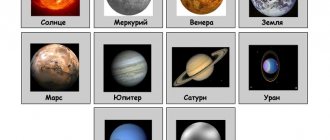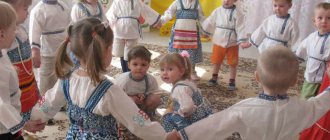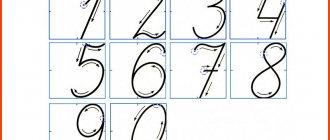“Fairytale labyrinth games” is the name of the method of educational games by Vyacheslav Voskobovich. A physics engineer by training, Voskobovich came up with games for his own children. As a person far from official pedagogy, he understood and knew what we remember from our childhood: a child loves games and fairy tales, not study and moralizing.
Most parents understand the need for their child's early development. But often this development is perceived as early training using some progressive method. This bears fruit: the baby begins to reason, read, count early, and goes to school prepared.
But sometimes parents realize too late that they have simply deprived their child of childhood: from the age of three (and sometimes earlier) all he does is study and do homework, but he doesn’t know how to play at all, and he doesn’t have time. We forget that play is the main activity of a preschooler. Through play, a child discovers the world, learns, communicates, and develops. So if you want to develop your child in accordance with nature’s plan, find time not only for activities, but also for playing with him - and you will achieve more, and even with pleasure. Voskobovich's games provide unlimited opportunities for development in the game.
Why choose Voskobovich's games?
- The games are based on fairy tales. In the game, the child helps fairy-tale characters by completing certain tasks. The plot of the fairy tale captivates and does not allow you to quit halfway. Training is entirely subordinated to a fairy tale plot. In addition, fairy tales always teach good things. You can always abandon the fairy-tale basis of the game or come up with your own.
- The main goal of Voskobovich’s games is to develop the child’s intelligence. They are structured in such a way that each subsequent task slightly exceeds the child’s capabilities (from the zone of proximal development).
- Any game by Voskobovich develops fine motor skills, spatial and logical thinking, combinatorics, imagination, and reveals creative potential. Games affect memory, attention and perseverance.
- In addition to development, including intellectual development, the goal of every game is learning. But adults know about this, not children. Children learn “accidentally” through play. This method of teaching is the only correct one in preschool age. Each game teaches something special: reading, counting, numbers, letters, colors, shapes, or several concepts at once.
- Voskobovich’s method can be combined with any other developmental method, because it is useful for any child to buy a new game.
- Children who play Voskobovich's games begin to read and count early, have good memory, perseverance, developed imagination and a stable psyche. They learn easily at school.
- In Voskobovich's games there is no place for adult violence against a child. The image of a strict teacher is impossible in the game: all players are equal. The parent’s task is to explain the rules of the game and play with the baby or observe, guide, and ask questions.
- Games form a lifelong style of communication between parent and child: cooperation, partnership based on mutual interest, and not mentoring, adult supremacy.
- Even an inexperienced parent will not be able to overload the child. In play, children themselves regulate the time and types of activities.
- Any parent will be able to choose a game to suit their budget. Prices for games depend on the materials from which they are made: cardboard ones are cheaper, plywood ones are more expensive.
- The games are intended for children of different ages (from two years old to primary and even middle school students). They are most useful for babies and preschoolers. Sometimes there are several options (sets) of the game for different ages: “Math Baskets”, “Voskobovich Square”. Or the same game has different rules for children of different ages: “Geocont”.
Telling fairy tales using the square of V. V. Voskobovich
Aigul Zainutdinova
Telling fairy tales using a square by V.V. Voskobovich
Telling fairy tales using a game square by V. V. Voskobovich .
The game square consists of 32 rigid triangles glued to a flexible base on both sides. Thanks to this design the square can be easily transformed, allowing you to design both planar and volumetric figures. The square can be two or four colors.
By folding a square, you can introduce children to geometric shapes such as square , rectangle, triangle and their properties. By playing with a square, children develop imagination, attention, logic, thinking, and memory. Also, games with the Voskobovich square contribute to the development of children's speech. By playing the Voskobovich square, children compose their own story.
Our goal is to introduce children to the Voskobovich square ; develop thinking, imagination, speech using innovative technologies.
When we started working with the Voskobovich square, we focused on telling familiar fairy tales using the square (Teremok, Cinderella)
, and also invited the children to fantasize with
the square and compose their own fairy tale .
We started working with square B. V. Voskobovich from the middle group , but we believe that it can also be used for younger children. Working with square B. V. Voskobovich , we developed the imagination of children, giving them the opportunity to fantasize, we offer the beginning of a fairy tale , and the children continue it in turn. (for example: Once upon a time there was a square and one day he ended up in the forest) children begin to fantasize about what could happen the square In this way, imagination and speech develop, children become liberated and are not afraid that they will say that something is wrong, because this is their fairy tale .
In addition, children can compose their own fairy tale . Also, working with a square, we suggest telling an already familiar fairy tale , for example “Teremok”
in this case, we offer children diagrams for folding
a square . Children, when telling a fairy tale , put together a house , candy, etc. from a square. In this way, fine motor skills of the hands develop.
, mostly children tell familiar fairy tales using square B. V. Voskobovich , inventing and changing the plot of a fairy tale . Then continuing to work with square B. V. Voskobovich in the senior and preparatory school groups, we propose to come up with and tell a fairy tale about “Cinderella”
This is a familiar
fairy tale , children telling it can change the plot of the fairy tale . And then the children independently come up with and act out their own fairy tale using square B. V. Voskobovich . We introduced B squares . V. Voskobovich made with his own hands, two and four colors. Children have the opportunity to take squares and play them independently.
Game squares B. V. Voskobovich not only for telling fairy tales , but also in educational activities.
We consider the use of squares B. V. Voskobovich has a beneficial effect on the development of preschool children, helps develop imagination , thinking, fine motor skills, and speech.
“Fairytale lesson” or introduction to the fairy tale “Winged, Shaggy and Oily” using a transparent square by V. Voskobovich Purpose: To introduce children to the Russian folk tale “Winged, Hairy and Oily” and help them understand its meaning. Objectives: Educational: To introduce.
Summary of OOD on FEMP using educational games by V.V. Voskobovich in the middle group “Wonderful transformations of a square” on the topic: “Wonderful transformations of a square based on the fairy tale by V.V. Voskobovich “The Mystery of the Raven Meter, or the Tale of Amazing Adventures of Transformations.”
Summary of the game OOD on FEMP with the help of educational games by V.V. Voskobovich in the middle group “Journey to the Digital Circus” on the topic: “Journey to the Digital Circus” together with parents Goal: to attract the attention of parents to their intellectual and creative development.
Abstract of the GCD for FEMP “Dividing a square into two equal parts” Topic: “Dividing a square into 2 equal parts” Goal: developing in children positive motivation for learning, FEMP. Ability to divide a square into two.
Summary of a lesson on speech development “Teaching children to tell Russian folk tales using a matrix picture” Goal: developing the ability to tell a fairy tale using a matrix picture. Objectives: Educational: to develop children’s ability to tell stories.
Summary of a lesson on speech development “Teaching children to tell Russian folk tales using visual modeling” Department of Education of the Nizhny Novgorod City Administration Municipal budgetary preschool educational institution “Kindergarten.
Lesson summary “Three squares” “Three squares” Purpose: to teach children to correlate three objects by size and indicate their relationships with the words: “big”, small”, “medium”.
Telling and modeling fairy tales using mnemonic tables. OOD in the middle group “Fairy Tale Confusion” OOD – in the middle group “Fairy Tale Confusion” Telling and modeling fairy tales using mnemonic tables. Goal: Teach children to restore.
Development of mental abilities of children of senior preschool age with the help of games by V.V. Voskobovich Voskobovich's Square is an educational fairy tale for a preschooler. Most modern toys are disposable and useless, they are quick.
Lesson on FEMP. Topic: “In the country of square and triangle” Lesson on FEMP. Topic: “Journey to the land of squares and triangles” Purpose: to teach children to distinguish and correctly name a square and a triangle;
Source
Games for children from 2 years old
Some games are suitable for children over two years of age. It's all about how to use the game. The main developmental task for babies 2-4 years old is the development of fine motor skills (movements of fingers and hands in general). There is a relationship between the development of fine motor skills and speech: the better the baby’s fingers, the better he speaks (and then writes). Most of Voskobovich's games develop fine motor skills. In the game "Geokont" you need to put rubber bands on pins, creating different shapes, in the game "Voskobovich Square" fine motor skills are developed due to the bends of the figure on a rigid fabric base. In the game “Plop-Plop Boat” you need to put rough multi-colored sails-flags on wooden stick masts; in the lacing games “Chamomile” and “Letter Constructor”, fine motor skills and different surfaces of objects are also involved. The game “Miracle Crosses” for this age is similar to large puzzles: shapes are made from colored parts. The game "Folds" contains a disk with songs. It develops the speech of children of this age. The games "Voskobovich's Cubes" and "Letter Constructor" give the first idea of letters.
Games
The author suggests considering your games as a set of activities from 2 to 7 years old. But in practice, they can be used separately - most puzzles are independent and do not require additional investment. Buying a set is interesting only because of the variety of activities and the expanded possibilities of using each element.
"Purple Forest"
The main environment for conducting classes using the Voskobovich method. The carpet base makes it easy to move and place additional elements around the space, to which Velcro is attached. The basic equipment is designed to familiarize the child with the environment, study the seasons, and natural phenomena.
Set of basic parts corresponding to:
- trees and colorful leaves;
- clouds, sun and moon;
- the most popular animals of the forest;
- design for lake and forest areas.
On a carpet base, the teacher can attach both ready-made factory objects and characters, drawing the child into the game, and those made independently. You can involve your child in the process of inventing new stories and personalities. It is enough to attach Velcro to the craft so that the craft becomes an inhabitant of the purple forest.
As they grow older, the characters can change, and the space can turn from a forest into a preschooler’s room. Manufacturers offer to buy not only cardboard and wooden figurines for the Violet Forest, but also watches, technical devices and complex puzzles. The base remains the same. Recommended age: 2-7 years.
"Boat Plop-Plop"
Plastic boat with five multi-colored masts. The masts are perforated and consist of segments that are put on according to the pyramid principle. The game invites you to thread multi-colored strings through the holes - to study colors, shapes, and sizes in the game.
Attached to the independent kit is a training manual that contains the most popular author's puzzle tasks for the little ones. At the same time, parents can come up with an unlimited number of their own tasks or suggest that the child come up with a task for the teacher. Recommended age: from one year.
"Geocont"
Voskobovich's geokont is a plywood base with lacing supports attached to it. The supports are labeled, which allows you to give tasks to reproduce not only a specific drawing, but also a route along a kind of map with marked points. Colored elastic bands are included.
Based on Geokont Voskobovich, you can learn letters and numbers, teach spatial thinking (display objects from different sides and in mirrors), conduct creative activities on drawing with non-traditional materials. The author proposed several geocont options designed for different age groups. Age from 3 to 7 years.
"Voskobovich Square"
Eternal origami is a puzzle made from laminated cardboard. The child will have to assemble shapes and objects from the red and green triangles applied to the base.
The game develops thinking, logic, and fine motor skills. A manual with assembly options is included in the kit. Recommended age: 2 to 7 years.
"Math baskets"
A number of activities can be carried out based on the set with numbers. Your helpers will be the Numbers from the Violet Forest, who collect mushroom numbers after the rain.
The child learns numbers and order, trains mental calculation and observation skills in a playful way. Additional elements of the Chest kit can be purchased separately, diversifying the process.
"Foldings"
A series of cards with short nursery rhymes, using which a child learns to read by syllables (words). In this game, the author modernized the popular method of teaching early reading by N. Zaitsev. The game is designed for children from 3 years old.
"Digital Circus"
The set is part of the Purple Forest, one of its zones. The director of the circus is Magnolik. He will introduce children to counting, shapes, and sizes. Children will compare and look for commonalities, and operate with simple mathematical operations.
Digital Circus additions:
- Flashlights - sizes, shapes, colors;
- Number constructor - introduction to mathematical concepts;
- Petals - concepts of color;
- Planet of multiplication - memorizing the table.
A manual with rules for organizing classes and popular supporting stories is included in the kit. Recommended age: from 3 years.
Games for children from 4-5 years old
All of the above games are also suitable for children of older preschool age, but they are played differently. The goal of this age: knowledge of the world and its laws in the game. The game "Geocont" gives an idea of colors, sizes and shapes, and teaches how to compare shapes by shape. The games “Voskobovich Square” and “Miracle Crosses” teach you how to create models using diagrams. The game "Plop-Plop Boat" gives an idea of the division of objects by color and quantity. The game “Folds” teaches you to divide a word into syllables and distinguish between vowels and consonants. The games “Chamomile”, “Snowman”, “Apple Tree” help with the help of lacing to form words from letters, and the game “Letter Constructor” makes it possible to remember the letters themselves. The game “Math Baskets” gives an idea of the composition of a number (you need to add mushrooms to the basket up to ten), prepares the pen for school (the child traces and shades, colors the mushrooms). The game “Teremki Voskobovich” is a unique simulator for teaching reading. The basis is syllables, not letters, as in traditional cubes.
The game "Reader on Balls" strengthens reading skills. Depending on the fold line, you can read short (2 letter) or long (6 letter) words (up to 130 words in the game). The game “Miracle Flower” gives the initial concept of fractions (parts of a whole) and teaches them to distinguish colors.
Game plus fairy tale
The first principle of the “Fairytale Mazes Games” technology is game-based learning for preschool children. The idea of developing children through play is not new. What is new here is that almost the entire learning process of a preschool child is actually built through play. The technology “Fairytale labyrinths of games” is a game form of interaction between adults and children through the implementation of a certain plot (games and fairy tales). At the same time, educational objectives are included in their content.
Educational games make learning an interesting activity for a child, relieve motivational problems, and generate interest in the acquired knowledge, skills, and abilities. The use of educational games in the pedagogical process allows you to rebuild educational activities: move from the usual activities with children to cognitive play activities, organized by adults or independently. Communication with adults in play, tinged with positive emotions, performing interesting play tasks, and bright, colorful design of play aids makes a child’s stay in a preschool institution joyful. As a rule, games do not leave either children or adults indifferent and give impetus to creative manifestations.
Methodological fairy tales also provide additional gaming motivation. A system of questions, tasks, exercises, and assignments is organically woven into their plot. It’s very convenient - you read a fairy tale, the child listens to it and, as the story progresses, answers questions, solves problems, and completes assignments. Fairy tales in the “Fairytale Mazes Games” technology are the author’s.
“Fairytale labyrinth games” is a purely gaming technology (author’s fairy tales; a large number of subject-based games aimed at various aspects of child development - mathematics, design, preparation for reading; joint games between children and adults), and this is its distinctive feature.
Tales of the Violet Forest
“One day, little Geo had a dream. He walks around the world for a day, a second, a third, and suddenly he meets the Red Beast. The kid got scared, ran, and suddenly a voice from above: “Don’t be afraid of the Red Beast, drive him away with an orange cry.” The baby shouted with an orange cry - the Red Beast disappeared, but a tree appeared, on the top of which the Yellow Bird sat. The Yellow Bird flapped its wings and circled, the Kid got scared and ran. And again the Voice: “Don’t be afraid of the Yellow Bird - drive it away with a green whistle.” The baby whistled with a green whistle - the Yellow Bird disappeared. A lake appeared and a boat stood on the shore. The Kid got into the boat, made a few strokes, and suddenly a Blue Fish swims out. The Kid got scared again and leaned on the oars, but that was not the case. And again the Voice: “Don’t be afraid of the Blue Fish, drive him away with a blue whisper.” The Kid whispered in a blue whisper - the lake disappeared, the boat disappeared. Geo stood in front of the entrance to the Violet Forest."
This is the beginning of the fairy tale “Baby GEO, the raven METER AND I” (the encrypted word GEOMETRY) for the game “Geokont”, where the Violet Forest of Voskobovich first appeared. A few years later, the “Purple Forest” development environment appeared in many Russian cities. These “scaffoldings” are very diverse: they are made from plywood, carpet, painted on the wall, fabric. In essence, a developing sensorimotor zone is created. The child acts independently in it: plays, designs, training those skills that he acquired in joint activities with an adult. In the Violet Forest there are always fairy-tale characters - Invisible All, Raven Meter, Baby Geo, Lopushok and others.
Games for children of primary and secondary school age
These are the same games, just used differently. The Geocont game introduces mathematical concepts such as coordinate systems. “Voskobovich Square” comes in two-color (for kids) and four-color (this is also suitable for schoolchildren). The game “Multiplication Planet” is intended for older children.
Without exception, all of Voskobovich’s games develop intelligence, logical thinking and fine motor skills. Therefore, according to the remaining developed qualities of the game (there are about 40 of them) they can be divided into three groups: developing spatial thinking, counting and reading skills. Most games are sold in two versions: with a fairy tale and without. By giving up a fairy tale, parents will lose a lot, because it is a fairy tale, like a game, that makes learning unnoticeable and involuntary for preschoolers. But this does not make it any less significant for parents.
Creation
Another principle of the “Fairy Tale Mazes Game” technology is the early creative development of preschool children. The game creates conditions for creativity and stimulates the development of the child’s creative abilities. An adult can only use this natural need to gradually involve children in more complex and creative forms of play activity.
Methods for implementing the “Fairy Tale Mazes Game” technology
The peculiarities of the technology are such that there is no need to rebuild the work of the institution, break the usual way of life and build a new one. Technology is organically woven into the already familiar rhythm of life and the educational objectives of the implemented program. The only difficulties the teacher faces are stereotypes of his own behavior. The game does not imply domination of the adult over the child in the “adult-child” relationship; it dictates partnerships. Did the teacher used to be the child’s partner in our kindergartens? It wasn't, and for many reasons. These are groups that are too “large” and these are also pedagogical postulates that had to be followed.
In preschool institutions using our technology, the child is surrounded by a relaxed, cheerful, intellectual and creative atmosphere that does not evoke negative emotions. Like lace from thin threads, it is woven from a feeling of external security, when the child knows that his manifestations will not receive a negative assessment from adults, and a feeling of internal relaxation and freedom due to the support of adults for his creative endeavors.






